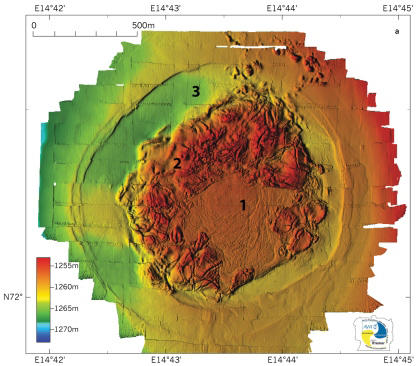Haakon Mosby mud volcano

Main content
In the last thirty years two kinds of oases of life have been discovered on the seafloor: hydrothermal vents and methane seeps. Organisms living in these oases live beyond the reach of sunlight and are part of a food chain that is based on chemosynthetic energy.
The discovery of these chemosynthetic oases has opened up new fields of research that have implications for understanding the origins of life and perhaps open up new possibilities for finding life on other planets. In addition, the research in this area is providing information that will help decision makers develop more informed policies relating to climate change strategies and CO2 storage legislation.
The Håkon Mosby mud volcano lies at 1250m deep on the seafloor south of Svalbard at 72°N. It is about one kilometre in diameter and rises a few metres above the seafloor. It was discovered in 1995.
Peter Vogt from the Naval Research Laboratory in Washington, DC writes that “Mud volcanoes and related cold-seep features form over great sediment accumulations in which bacteria digest buried organic matter, producing methane as a waste product. Specially evolved bacteria oxidize the methane, forming the foundation of a food chain. Different bacteria have evolved to oxidize the foul-smelling hydrogen sulfide, itself the waste product of yet other bacteria living below the ocean floor, which oxidize sulfate ions of seawater origin.” learn more
The volcano has been the object of intensive study since its discovery and there is extensive information available on the web.
The Håkon Mosby mud volcano published by the Alfred-Wegener Institute for Polar Research
an article from Marine Geology
an article about “Novel methane consuming microorganisms…” published by a team led by Max Planck Institute for Marine Microbiology
there are some nice images in this note from IFREMER
The German RV Polarstern has visited a number of times
